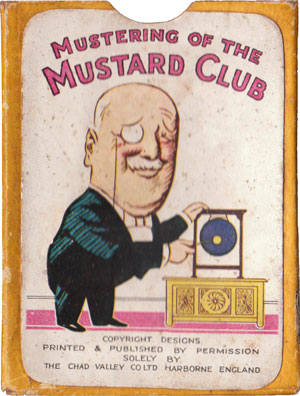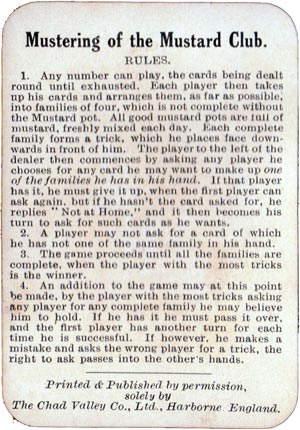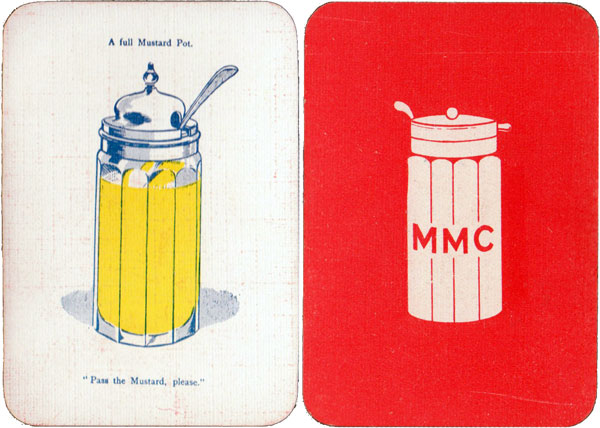Mustering of the Mustard Club
The “Mustering of the Mustard Club” was one of many promotional items produced by Colman's for the Mustard Club which was launched in 1926.

Mustering of the Mustard Club, 1926
The “Mustering of the Mustard Club” was one of many promotional items produced by Colman's for the Mustard Club which was launched in 1926. The cards were produced for Colman's of Norwich by the Chad Valley Co., Ltd of Harborne. Some of the illustrations appear to be slightly re-drawn and derived from those of an earlier Chad Valley Happy Families pack. The illustrator was the royalty artist John Thomas Young Gilroy ARCA, FRSA (1898-1985), also well known for his advertising posters for Guinness, and whose initials JG can be seen on many of the cards. In 1925 Gilroy joined the advertising agency S. H. Benson Ltd, working on major accounts including Bovril, Rowntrees and Colman’s mustard. The “Mustering of the Mustard Club” game consists of 24 cards + 6 Mustard Pot cards + a rules card inside a yellow slip case (shown right).
REFERENCES & CREDITS
Mary Gardiner & John Hayter: The Catalogue of Happy Family Games, promotional packs, self-published, 1997.
See also: Wikipedia article about John Gilroy→



By Rex Pitts (1940-2021)
Member since January 30, 2009
Rex's main interest was in card games, because, he said, they were cheap and easy to get hold of in his early days of collecting. He is well known for his extensive knowledge of Pepys games and his book is on the bookshelves of many.
His other interest was non-standard playing cards. He also had collections of sheet music, music CDs, models of London buses, London Transport timetables and maps and other objects that intrigued him.
Rex had a chequered career at school. He was expelled twice, on one occasion for smoking! Despite this he trained as a radio engineer and worked for the BBC in the World Service.
Later he moved into sales and worked for a firm that made all kinds of packaging, a job he enjoyed until his retirement. He became an expert on boxes and would always investigate those that held his cards. He could always recognize a box made for Pepys, which were the same as those of Alf Cooke’s Universal Playing Card Company, who printed the card games. This interest changed into an ability to make and mend boxes, which he did with great dexterity. He loved this kind of handicraft work.
His dexterity of hand and eye soon led to his making card games of his own design. He spent hours and hours carefully cutting them out and colouring them by hand.
Related Articles

OXO Faces of the Millennium Dinner
Twentieth-century personalities promoting a millennium dinner at the Oxo Tower in London.

Pathé Marconi
Special promotion pack for French record company Pathé Marconi.

Kids Fun Box playing cards
Colourful cards for children with four non-standard suits connected with the natural world.

Tangle Foot Ale
Badger Brewery Tangle Foot strong ale advertising pack.

ViVa Bourg
A distinctive deck of cards for a specific promotion.

Dancing
“Dancing” playing cards manufactured by Nintendo for Torii Dance School, Osaka.

Scientific Whist
“Scientific Whist” : standard cards with instructions for play on the faces by Chas Goodall & Son, 1...

Agent Provocateur
Branded lingerie collection in a pack of pin-up playing cards.

Shin-Tōmei Expressway Opening Commemoration
Promotional playing cards for the Shin-Tōmei Expressway, a major Japanese expressway that opened in ...

Nimbus playing cards
Mike Steer’s weather-themed pack with suits in four colours and backs for cardistry.

Agatha Christie and Playing Cards revisited
Agatha Christie uses card-play as a primary focus of a story, and as a way of creating plots and mot...

The Decadent Deck
Studies in the eroticism of the female body by Inge Clayton.

Historic Shakespeare
“Historic Shakespeare” playing cards featuring Shakespearean characters by Chas Goodall & Son.

Copechat Paramount Sorting System
Preserving the past: a specimen deck showcasing edge-notched cards and their ingenious sorting syste...

Heartsette by Herbert Fitch & Co, 1893
A glimpse into a busy print and design office in late Victorian London.

Intersigma
A Czech advertising deck for a company dealing with pump technology.
Most Popular
Our top articles from the past 28 days







